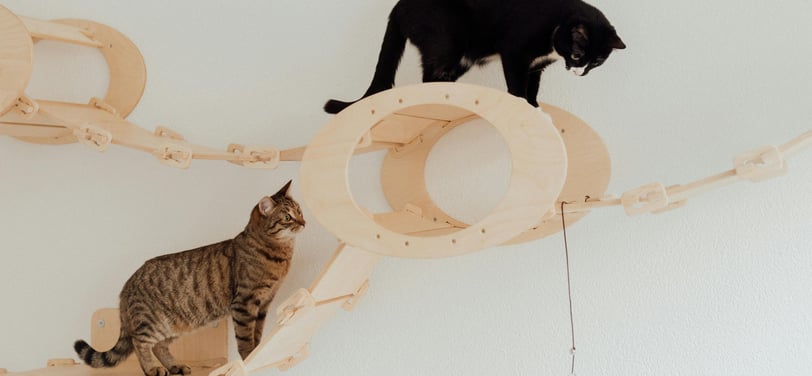Five Different Types of Interactive Cat Toys to Keep Your Feline Engaged
Cats thrive on stimulation and play. Interactive cat toys are an excellent way to keep felines engaged, physically active, and mentally stimulated. They cater to a cat's natural hunting instincts while fostering a bond between pets and their owners.
10/29/20244 min read
The links in this article are from my personal amazon affiliate link. Which gives me a small percentage of revenue.


Cats thrive on stimulation and play. Interactive cat toys are an excellent way to keep felines engaged, physically active, and mentally stimulated. They cater to a cat's natural hunting instincts while fostering a bond between pets and their owners.
There are various types of interactive cat toys available, each designed to appeal to specific behaviors and preferences. These toys can range from simple feather wands to sophisticated electronic devices that mimic prey movements. Understanding the different types can help cat owners choose the best options for their pets, ensuring hours of entertainment and exercise.
Exploring these five categories of interactive cat toys will provide insights into enhancing playtime for any cat. This knowledge can lead to a happier, healthier feline companion, transforming routine play into a more enriching experience.
Understanding Cat Behavior and the Need for Interactive Toys
Interactive toys play a crucial role in enhancing a cat's quality of life. They provide essential opportunities for play, which fosters both physical activity and mental engagement.
The Science of Play: Benefits for Feline Development
Play is a fundamental aspect of a cat's development. It helps young cats learn necessary skills such as hunting and social interaction. Adult cats also require play to maintain their agility and cognitive function.
Research indicates that playtime leads to increased confidence in cats. Engaging with toys can mimic real-life hunting scenarios, offering them a safe outlet for their natural instincts. Frequent interaction with such toys can result in better-adjusted and happier pets.
Physical Activity: Combating Feline Obesity with Interactive Play
Many domestic cats face obesity due to sedentary lifestyles. Interactive toys encourage movement, burning calories and promoting a healthy weight. These toys often mimic the erratic movements of prey, enticing cats to chase and pounce.
Incorporating active play into a cat's daily routine is essential. Options like feather wands, laser pointers, or battery-operated toys can keep a cat physically engaged. Regular exercise through play can also reduce the risk of health issues like diabetes and joint problems.
Mental Stimulation: How Interactive Toys Prevent Boredom
Boredom can lead to destructive behavior in cats. Interactive toys serve as a solution by providing mental challenges. Puzzle feeders, for instance, require cats to solve problems to access treats, keeping them entertained and stimulated.
Diverse toys that change engagement levels can cater to various personality types. Toys that allow for solo play are important for owners with busy schedules, ensuring that the cat remains mentally engaged. Regularly rotating toys can help sustain interest and prevent monotony.
Types of Interactive Cat Toys
Interactive cat toys enhance playtime and provide mental stimulation, catering to a cat's natural instincts. The following types of toys are designed to engage felines physically and mentally.
Electronic Motion Toys
Electronic motion toys simulate the movement of prey, captivating a cat's attention. These toys typically have features like random paths and speeds to mimic unpredictable movements.
Some popular variations include battery-operated mice and robotic toys that roll or dart around. Most models also incorporate sound effects to further intrigued curious cats.
Using these toys encourages active play and can help reduce boredom. They are particularly useful for cats who need more exercise or have limited outdoor time.
Interactive Puzzle Feeders
Interactive puzzle feeders offer a way to combine feeding and play. They challenge cats to manipulate objects to access food or treats, promoting mental engagement.
These feeders come in various designs, including sliding panels and rotating compartments. Cats must figure out how to operate them, enhancing their problem-solving skills.
Utilizing these toys can slow down fast eaters, improving digestion. Many owners find that these tools reduce weight and encourage healthy eating habits in their cats.
Interactive Lasers and Light Toys
Interactive laser and light toys serve to stimulate a cat’s predatory instincts through light projection. These create enticing beams that cats chase, providing vigorous exercise.
Laser pointers offer adjustable settings, allowing users to create a variety of movements. Battery-powered light toys can project rotating designs, adding excitement to the chase.
However, it is essential to avoid frustration by ending play sessions with an actual toy for the cat to catch. This method ensures cats remain engaged and satisfied after their playtime.
Wand and Teaser Toys
Wand and teaser toys consist of long handles with attached strings or feathers. These toys allow owners to play with their cats without direct contact, keeping hands safely away.
They encourage interactive play, strengthening the bond between cat and owner. Additionally, cats benefit from the exercise these toys provide, helping maintain a healthy weight.
Choosing a variety of attachments can keep playtime fresh and exciting. Regular interaction with these toys can also reduce destructive behavior in cats as they expend energy in more appropriate ways.
Interactive Track and Ball Toys
Track and ball toys feature a ball encased within a track, allowing cats to paw at it while it spins. These toys are simple yet effective, providing endless entertainment.
Cats can bat the ball around, stimulating their hunting instincts and offering physical exercise. Many designs come equipped with additional features like lights or sounds that activate during play.
These toys are suitable for single cats or households with multiple felines. Their stationary nature makes them a safe option that enhances independent play, reducing the need for constant supervision.
